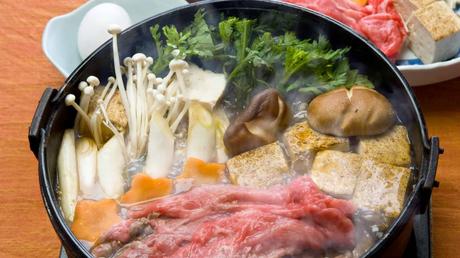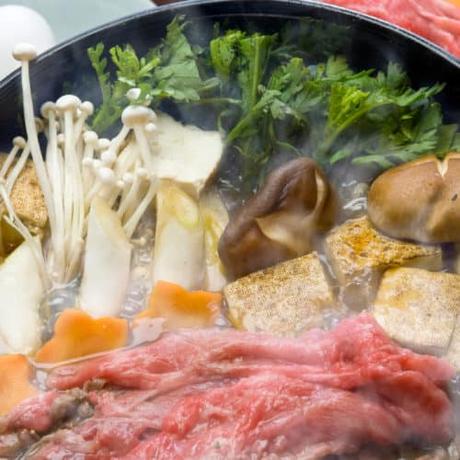What better way to host a get-together with friends and family than with a comforting hot pot dish with tasty beef and veggies, all in a sweet and savory soy broth?
If you like delicious hotpot foods, then you’re going to be a fan of this easy recipe. There’s no doubt sukiyaki is one of Japan’s favorite hot pot dishes, and it might just become yours too!
Eating sukiyaki is fun – it’s all cooked and served at the table from the pot, and everyone gets to eat the ingredients in the order they want and crack their own egg into the bowl.

Then at the end of the meal, you get to enjoy chewy udon noodles.
The good news is, making sukiyaki only takes about 30 to 40 minutes. Eating it is the fun part, though, so take your time!
How to make sukiyaki at home
 Print
Print
Beef sukiyaki recipe
The original beef sukiyaki recipe calls for raw eggs, but I leave it out because raw eggs can cause food poisoning. You can add some poached egg, though, for that eggy flavor. Course Main CourseCuisine JapaneseKeyword Hot pot Prep Time 20 minutesCook Time 20 minutes Servings 3 Author Joost Nusselder Cost $10Ingredients
For the sauce:
- 2 tbsp sake
- ¼ cup soy sauce
- ¼ cup mirin
- 1 tbsp brown sugar
For the rest of the sukiyaki:
- 12 oz very thinly sliced beef fatty and marbled preferably
- ½ block of tofu firm
- 1 package enoki mushrooms
- 6 shiitake mushrooms fresh or re-hydrated
- 2 cups of nappa cabbage shredded (regular cabbage works too)
- 2 scallions chopped
- 1 bundle of shirataki or vermicelli noodles
- 1 tbsp vegetable oil
- 2 cups dashi
- 2 cups steamed rice
- 1 cup of tong ho or shungiko optional or use chopped parsley
Instructions
- Grab a large saucepan. Over medium heat, add in the mirin, sake, soy sauce, and brown sugar while stirring. Bring to a boil, and then turn the heat off. Put the sauce into a bowl for later use.
- Soak the noodles for about 10 minutes in water.
- While the noodles soak, chop all of your ingredients, slice the beef, and set them aside. Cut the tofu into ¼ inch pieces. The beef must be sliced into almost paper-thin strips.
- Heat up the vegetable oil in the pan. Cut the white parts of the scallion separately and fry them in oil for a couple of minutes.
- Now add in the beef. Sear the beef for 20 seconds, and then add a small drizzle of sukiyaki sauce. Continue frying the beef until it starts to brown. Once it’s almost all brown but still has a bit of pink color, remove the meat from the pan and set it aside for later.
- Add the remaining sukiyaki sauce to the pan and the 2 cups of dashi stock. Bring the liquids to a boil and the tofu, cabbage, mushrooms, and tong ho or parsley. Push the ingredients to one side of the pan.
- Drain the noodles and add them to the other side of the pan. Cover the pot and bring everything to a simmer and let it cook for about 7 minutes.
- Remove the lid and add the beef back to the pot. Now you can add the green part of the scallions and poached eggs if you want.
Sukiyaki pan
Before I move on to the recipe, I want to talk to you about this special sukiyaki pan they use in Japan.
It is a large cast-iron pan with a wooden lid and a long thin handle, like a basket handle.
The pan has high edges to make room for lots of liquid. It is designed explicitly for sukiyaki, but you can use it for most hot pot dishes.
The wooden lid helps absorb the steam and liquids from the hot pot much better than a metal or iron lid. Since the sukiyaki pan is large, it is ideal for cooking for a family of up to five people.
If you like to cook hot pot meals, I highly recommend grabbing a sukiyaki pan from Amazon.
If you don’t have a sukiyaki pan, you can use a regular cast-iron pan or one with a thick bottom and high edges.
Side dishes for sukiyaki
The most common side dish for sukiyaki is white rice. A bowl of white rice goes well with this saucy beef and veggie mixture and also helps keep you fuller for longer.
But, there’s a Japanese tradition where people have a bowl of udon noodles along with sukiyaki or right after they finish the sukiyaki.
If you’re a huge noodle fan, go for it, but since the sukiyaki already contains shirataki or vermicelli noodles, you might already feel full.
The general sukiyaki etiquette is that you finish off the dish with more carbohydrates like noodles.
As I’ve mentioned, Japanese people love to dip sukiyaki ingredients into raw eggs, but if you do so, the egg must be fresh and preferably pasteurized.
Read more about this: Why do the Japanese put Raw Egg on Rice? Is it safe?
What is Sukiyaki?
Sukiyaki (すき焼き) is a Japanese hot pot dish, similar to Shabu Shabu. It’s a bold-tasting dish with beef and vegetables cooked with tofu and noodles in a sweet and salty soy sauce broth.
The dish is made in a special cast-iron pot. First, the thin slices of beef are seared, and then all the other ingredients are added, including a tasty broth.
The main ingredients for sukiyaki are beef or pork, leafy vegetables (spinach, cabbage, bok choy), mushrooms (enoki, shiitake), tofu, egg, and a sweet and salty soy sauce broth.
Sukiyaki is a hot pot dish, and this means that the dish is cooked on a tabletop grill by the diners. Every diner can use chopsticks to add more ingredients to the pot, eat it, and add more.
You’ll most often see people eating sukiyaki during their lunch break. It’s a typical hot pot dish, and colleagues gather around the table to have a quick yet filling meal.
Check out this Guide to Sukiyaki steak | recipe, cutting technique and flavors
Regional sukiyaki variations
Two main types of sukiyaki are popular in different regions of Japan.
Kansai & Kanto style
Kansai is the Osaka region, whereas Kanto refers to the Tokyo region.
Kansai sukiyaki is different because the meat is seared first, along with soy sauce, sake, and sugar. Then, diners taste some of the meat before the other ingredients are added to the pot.
In Kanto sukiyaki, the sauce, called Warishita, 割り下, is cooked first, and then all the ingredients are added to the sauce and cooked together.
In terms of meat, this dish requires a special thinly sliced beef. It’s usually labeled as sukiyaki or shabu shabu meat in Asian grocery shops. It’s sliced to the perfect thinness specifically for this dish.
The meat must be well-marbled, and it should be a premium cut of beef. For the ultimate sukiyaki hot pot experience, try Wagyu beef which is extremely expensive but very tasty.
How to serve and eat sukiyaki
In Japan, it’s a common tradition to dip hot pot ingredients in raw eggs. This is not very appetizing to people who aren’t used to eating raw eggs.
In the West, it’s prohibited to consume raw eggs at restaurants. But, in traditional Japanese restaurants in Asia, you will see people consuming sukiyaki this way.
An alternative is to buy pasteurized eggs from the supermarket. But you can also just dip into poached eggs.
The sukiyaki is cooked on a tabletop stove in a cast-iron pot. Each person can add ingredients to the pot using chopsticks.
As soon as the ingredients start to run out, people add more and cook it. It’s a great dining style for groups of people because you can simultaneously cook, eat, and socialize.
Sukiyaki recipe substitutions and variations
Beef is a must-have ingredient if you want authentic sukiyaki. And it should be a fatty and marbled beef that’s going to add juiciness.
Of course, you can use very thin slices of pork or chicken if you don’t like beef.
Some of the Japanese ingredients, like napa cabbage, are harder to find in the West. But the good news is that you can use the leafy greens you can find at the supermarket, and the dish will have a very similar flavor.
Shungiku (crown daisy), or tong ho in Chinese, is the traditional herb used in Japanese and Chinese hot pot dishes.
It’s hard to find outside of Japan. It has a slightly bitter taste. You can use parsley and cilantro as a substitute.
The best vegetables to use are white cabbage, red cabbage, bok choy, spinach, and shiitake mushrooms.
The traditional recipe contains a type of green onion called Tokyo Negi. If you can’t find it, use scallions, spring onions, or leeks for a similar sweet and savory flavor.
Noodles: the recipe calls for shirataki noodles. These are long white noodles made from the Konjac plant.
A great substitute for these noodles is vermicelli which has a similar glass noodle appearance and texture. Shirataki noodles are popular because they are considered to be a “zero-calorie” noodle.
Origin of sukiyaki
Sukiyaki started out as a celebratory meal for families to gather around the table, cook, and eat together. Like all hot pot dishes, it is a great way to spend time together, especially during important occasions.
Sukiyaki was invented sometime in the 1860s in the Edo period when eating beef was allowed.
The name of the dish is a mix between the word “suki,” which means “spade,” and “yaki,” which is “grilled”. It references the fact that the beef is paper-thin and cut with a blade. As well, farmers used a spade to cook their food over the grill.
During the 1860s, Japan experienced an influx of new foods and foreign cooking methods. A lot of chefs began to experiment more with beef, eggs, and cow’s milk.
Thus, dishes like sukiyaki became popular. It’s believed that the first Sukiyaki restaurant opened in Yokohama in 1862. They served Kanto-style sukiyaki, and everything was cooked and simmered in the sauce.
Read more about Japanese beef: Incredibly Easy Way to Cook Beef Misono Tokyo Style
Conclusion
Well, I’m not surprised sukiyaki is so popular to this day. The juicy beef in that sweet and savory sauce is so tasty, and you just can’t get enough.
The crunchiness of the cabbage and the bitterness of tong ho make this a dish with many flavors. It’s definitely a crowd-pleaser and a family favorite across Asia.
I’m sure we’ll be seeing more sukiyaki restaurants pop up across North America because hot pot meals are such a fun way to dine with friends and family.
For more crowd-pleasers, read Best Sushi Making Kit | Top 6 reviewed +some sushi party tips
